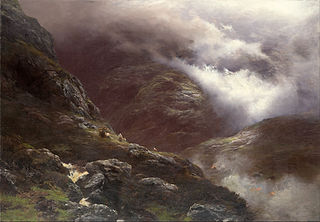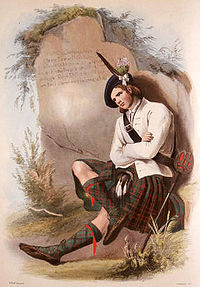
The Massacre of Glencoe took place in Glen Coe in the Highlands of Scotland on 13 February 1692. An estimated 30 members and associates of Clan MacDonald of Glencoe were killed by Scottish government forces, allegedly for failing to pledge allegiance to the new monarchs, William III and Mary II.

Clan Campbell is a Highland Scottish clan, historically one of the largest and most powerful of the Highland clans. The Clan Campbell lands are in Argyll and within their lands lies Ben Cruachan. The chief of the clan became the Earl and later Duke of Argyll.

Clan Donald, also known as Clan MacDonald, is a Highland Scottish clan and one of the largest Scottish clans. The Lord Lyon King of Arms, who is the Scottish official with responsibility for regulating heraldry in that country, issuing new grants of coats of arms, and serving as the judge of the Court of the Lord Lyon, recognizes under Scottish law the High Chief of Clan Donald. Historically the chiefs of the Clan Donald held the title of Lord of the Isles until 1493 and two of those chiefs also held the title of Earl of Ross until 1476.

Clan MacLean is a Highlands Scottish clan. They are one of the oldest clans in the Highlands and owned large tracts of land in Argyll as well as the Inner Hebrides. Many early MacLeans became famous for their honour, strength and courage in battle. They were involved in clan skirmishes with the Mackinnons, Camerons, MacDonalds and Campbells, as well as all of the Jacobite risings.

Robert Campbell, 5th Laird of Glenlyon, was a minor member of Scottish nobility and is best known as one of the commanding officers at the Massacre of Glencoe.

John Campbell, 1st Earl of Breadalbane and Holland, son of Sir John Campbell of Glen Orchy, and of the Lady Mary Graham, daughter of William Graham, 1st Earl of Airth and 7th Earl of Menteith, was a member of Scottish nobility during the Glorious Revolution and Jacobite risings and also known as "Slippery John". An astutely political man, Campbell was one of the men implicated in the Massacre of Glencoe.
Argyll's Regiment of Foot was a Scottish infantry regiment formed in April 1689 to suppress Jacobite opposition in the Highlands. In February 1692 it took part in the Glencoe Massacre, moved to Brentford near London in May then to Flanders in early 1693 where it fought in the Nine Years War. It became Lord Lorne's Regiment in April 1694 and was disbanded on February 1697.

Clan MacDonnell of Glengarry is a Scottish clan and is a branch of the larger Clan Donald. The clan takes its name from Glen Garry where the river Garry runs eastwards through Loch Garry to join the Great Glen about 16 miles (25 km) north of Fort William, Highland.
John MacDonald, known as Iain Lom was a Scottish Gaelic poet.

Clan MacIntyre is a Highland Scottish clan. The name MacIntyre, means "son of the carpenter" Although no documented history of the clan exists, it is most commonly said to descend from Maurice Mac Neil a nephew of Somerled, the great 12th century leader of the Scottish Gaels. Through an ingenious strategy, Maurice secured the marriage of Somerled to the daughter of the King of Mann and the Isles, thus greatly increasing Somerled's territories. At an unknown date the clan journeyed from the Hebrides to the Scottish mainland where the chiefs established their home at Glen Noe, in Ardchattan Parish, on the east side of Loch Etive.

The Clan Henderson is a Scottish clan. The clan's historical seat is at Fordell Castle in Dalgety Bay, Fife. The current clan chief is Alistair Henderson of Fordell.

Clan Macdonald of Clanranald, also known as Clan Ranald or Clan Ronald, is a Highland Scottish clan and a branch of Clan Donald, one of the largest Scottish clans. The founder of the Macdonalds of Clanranald is Reginald, 4th great-grandson of Somerled. The Macdonalds of Clanranald descend from Reginald's elder son Allan and the MacDonells of Glengarry descend from his younger son Donald. The clan chief of the MacDonalds of Clanranald is traditionally designated as The Captain of Clanranald and today both the chief and clan are recognised by the Lord Lyon King of Arms, the heraldic judge in Scotland.

Clan Maclachlan, also known as Clan Lachlan, Clann Lachainn (Argyll), and Clann Lachlainn, is a Highland Scottish clan that historically centred on the lands of Strathlachlan on Loch Fyne, Argyll on the west coast of Scotland. The clan claims descent from Lachlan Mor, who lived on Loch Fyne in the 13th century, and who has left his name upon the countryside he once controlled: places such as Strathlachlan, Castle Lachlan and Lachlan Bay. Tradition gives Lachlan Mor a descent from an Irish prince of the O'Neill dynasty, Ánrothán Ua Néill, son of Áed, son of Flaithbertach Ua Néill, King of Ailech and Cenél nEógain, died 1036. Clan Maclachlan has been associated with other clans, such as Clan Lamont, Clan Ewen of Otter, Clan MacNeil of Barra, and the MacSweens: as all claim descent from Anrothan O'Neill who left Ireland for Kintyre in the 11th century. From this descent the clan claims a further descent from the legendary Niall Noigíallach, High King of Ireland, who lived from the mid 4th century to the early 5th century.

Clan MacAlister is a Scottish Clan. The clan is the earliest branch to have split off from Clan Donald, claiming descent from Alasdair Mòr, son of Domhnall founder of Clan Donald. From Alasdair Mòr the clans takes its surname MacAlister; this surname is an Anglicisation of the Gaelic MacAlasdair meaning "son of Alasdair". In the 15th century the chief of the clan was seated in Kintyre, and the clan was centred there until the 18th century, when a chief sold the family estate in preference to an estate in the Scottish Lowlands.

Clan Macfie is a Highlands Scottish Clan.
Events from the year 1692 in the Kingdom of Scotland.
The Massacre of Glencoe is a 1971 British historical drama film directed by Austin Campbell and starring James Robertson Justice, Andrew Crawford and William Dysart. The film depicts the 1692 Massacre of Glencoe in Scotland.

Robert Duncanson, 1658 to May 1705, was a Scottish professional soldier from Inveraray; a retainer of the Earl of Argyll, he began his career during the 1685 Argyll's Rising, and is now best remembered for his involvement in the February 1692 Glencoe massacre.

Lady of the Glen: A Novel of 17th-Century Scotland and the Massacre of Glencoe is a 1996 historical fiction novel by American author Jennifer Roberson. It is a re-telling of the 1692 Massacre of Glencoe, and focuses on the romance between Catriona of Clan Campbell and Alasdair Og MacDonald of Clan Donald, each from rival clans.
Coll Macdonald, 16th of Keppoch (c.1664-1729), was a Scottish clan chief and prominent Jacobite, active in both the 1715 Jacobite rebellion and Dundee's rising of 1689. He was chief of the Macdonalds of Keppoch, holding land in Lochaber.
















